Showing Spotlights 161 - 168 of 240 in category All (newest first):
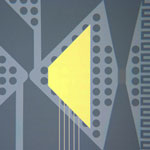 Currently, the most common methods for sizing nanoparticles extract data from bulk measurements. These techniques are inherently averaging and so are unable to effectively resolve mixtures of different-sized particles. While individual nanoparticles can be sized using electron microscopy, this approach is time-consuming and of little utility in assembling significant population statistics. Researchers have now developed a microfluidic device for the all-electronic analysis of complex suspensions of nanoparticles in fluid. This device is capable of detecting and sizing individual and unlabeled particles as small as a few tens of nanometers in diameter at rates estimated to exceed 100,000 particles per second.
Currently, the most common methods for sizing nanoparticles extract data from bulk measurements. These techniques are inherently averaging and so are unable to effectively resolve mixtures of different-sized particles. While individual nanoparticles can be sized using electron microscopy, this approach is time-consuming and of little utility in assembling significant population statistics. Researchers have now developed a microfluidic device for the all-electronic analysis of complex suspensions of nanoparticles in fluid. This device is capable of detecting and sizing individual and unlabeled particles as small as a few tens of nanometers in diameter at rates estimated to exceed 100,000 particles per second.
Mar 7th, 2011
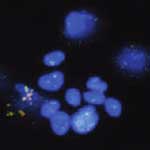 Multifunctional nanomaterials have become widely researched in nanomedicine with the goal of developing highly accurate probes for detecting and isolating cancer cells. Of particular interest here are magnetic nanoparticles, which offer the capability of cell isolation from original or enriched samples without the use of centrifugation or filtration. In particular, the combination of fluorescent quantum dots and magnetic nanoparticles into single nanospheres to obtain fluorescent-magnetic bifunctional nanospheres has created the potential for broader applications in biomedicine and in clinical diagnosis. In new work, researchers have now expanded this technique to multiplexed assays. They demonstrated the ability to detect and collect multiple types of cancer cells, such as leukemia cells and prostate cancer cells, from mixed samples within 25 minutes by using a magnet and an ordinary fluorescence microscope.
Multifunctional nanomaterials have become widely researched in nanomedicine with the goal of developing highly accurate probes for detecting and isolating cancer cells. Of particular interest here are magnetic nanoparticles, which offer the capability of cell isolation from original or enriched samples without the use of centrifugation or filtration. In particular, the combination of fluorescent quantum dots and magnetic nanoparticles into single nanospheres to obtain fluorescent-magnetic bifunctional nanospheres has created the potential for broader applications in biomedicine and in clinical diagnosis. In new work, researchers have now expanded this technique to multiplexed assays. They demonstrated the ability to detect and collect multiple types of cancer cells, such as leukemia cells and prostate cancer cells, from mixed samples within 25 minutes by using a magnet and an ordinary fluorescence microscope.
Mar 4th, 2011
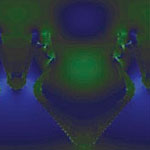 No matter how precise nanosensors and -probes become, bridging the huge gap between nanoscale dimensions and macroscale structures (e.g., wafer size) has been a tremendous challenge for researchers. Researchers in the U.S. have demonstrated a generalized hybrid nanofabrication concept that combines both top-down (deep-UV lithography) and bottom-up (controlled lateral epitaxial growth and atomic layer deposition) fabrication techniques. This unique methodology allows the development of reproducible nanostructured platforms that contain controlled sub-10 nm gaps between plasmonic nanostructures over an entire wafer, i.e. a 6-12 inch area. This approach opens new horizons to more widespread applications in chemical sensing and biomedical diagnostics.
No matter how precise nanosensors and -probes become, bridging the huge gap between nanoscale dimensions and macroscale structures (e.g., wafer size) has been a tremendous challenge for researchers. Researchers in the U.S. have demonstrated a generalized hybrid nanofabrication concept that combines both top-down (deep-UV lithography) and bottom-up (controlled lateral epitaxial growth and atomic layer deposition) fabrication techniques. This unique methodology allows the development of reproducible nanostructured platforms that contain controlled sub-10 nm gaps between plasmonic nanostructures over an entire wafer, i.e. a 6-12 inch area. This approach opens new horizons to more widespread applications in chemical sensing and biomedical diagnostics.
Mar 2nd, 2011
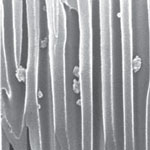 Research to develop sensors that can rapidly detect biomarkers (associated with certain diseases such as cancer) in whole blood, ideally at the point of care, and when the protein biomarker level in blood is very low (i.e. the disease is in an early stage) is being advanced by nanosensor technology. In a recent development, scientists in Spain have developed a rapid nanochannel-based immunoassay capable of the filtering and subsequent detection of proteins in whole blood without any sample preparation. This is the first time that a simple assay to detect proteins in whole blood using nanochannels has been achieved. This is a simple device and set-up that allows nanochannels to achieve such the double functionality of filtering and detection on the same platform.
Research to develop sensors that can rapidly detect biomarkers (associated with certain diseases such as cancer) in whole blood, ideally at the point of care, and when the protein biomarker level in blood is very low (i.e. the disease is in an early stage) is being advanced by nanosensor technology. In a recent development, scientists in Spain have developed a rapid nanochannel-based immunoassay capable of the filtering and subsequent detection of proteins in whole blood without any sample preparation. This is the first time that a simple assay to detect proteins in whole blood using nanochannels has been achieved. This is a simple device and set-up that allows nanochannels to achieve such the double functionality of filtering and detection on the same platform.
Feb 23rd, 2011
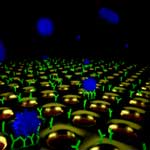 A multi-disciplinary research team has introduced a novel label-free optofluidic-nanoplasmonic biosensor and demonstrated direct detection of live viruses from biological media at medically relevant concentrations with little to no sample preparation. This novel platform can be easily adapted for point-of-care diagnostics to detect a broad range of viral pathogens in resource-limited clinical settings at the far corners of the world, in defense and homeland security applications as well as in civilian settings such as airports or other public spaces. This work is the first demonstration of detection of intact viruses using extraordinary light transmission phenomena in plasmonic nanohole arrays.
A multi-disciplinary research team has introduced a novel label-free optofluidic-nanoplasmonic biosensor and demonstrated direct detection of live viruses from biological media at medically relevant concentrations with little to no sample preparation. This novel platform can be easily adapted for point-of-care diagnostics to detect a broad range of viral pathogens in resource-limited clinical settings at the far corners of the world, in defense and homeland security applications as well as in civilian settings such as airports or other public spaces. This work is the first demonstration of detection of intact viruses using extraordinary light transmission phenomena in plasmonic nanohole arrays.
Nov 17th, 2010
 In order to improve throughput speed of DNA sequencing and reduce its cost, researchers are pursuing real-time solid-state DNA sequencing devices. To that end, electronic functional devices in liquid environments need to be developed, ideally utilizing the compatibility with current complementary metal oxide semiconductor (CMOS) based fabrication technology. In this regard, the combination of electronics and nanofluidics leads to the field of electrofluidics, which utilizes the electrical behaviors of fluids for solid state device applications. In order to explore the ion transport and biomolecule transport through nanochannels, researchers have now reported the fabrication of an electrofluidic platform to study the motion of single molecules, including DNA. The device's nanochannel structures were fabricated with sub-lithographic dimension through top-down based, conventional semiconductor fabrication methods.
In order to improve throughput speed of DNA sequencing and reduce its cost, researchers are pursuing real-time solid-state DNA sequencing devices. To that end, electronic functional devices in liquid environments need to be developed, ideally utilizing the compatibility with current complementary metal oxide semiconductor (CMOS) based fabrication technology. In this regard, the combination of electronics and nanofluidics leads to the field of electrofluidics, which utilizes the electrical behaviors of fluids for solid state device applications. In order to explore the ion transport and biomolecule transport through nanochannels, researchers have now reported the fabrication of an electrofluidic platform to study the motion of single molecules, including DNA. The device's nanochannel structures were fabricated with sub-lithographic dimension through top-down based, conventional semiconductor fabrication methods.
Oct 14th, 2010
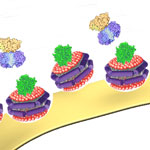 One of the tools developed by molecular biologists to study cell membranes and their associated proteins is a synthetic membrane model called Nanodisc. This is a self-assembled phospholipid bilayer disc of about 10 nm diameter, wrapped in a membrane scaffold protein belt. Nanodiscs render amphipathic and hydrophobic molecules easily soluble, offering transformative innovations across a broad range of applications in both in vivo delivery of therapeutics, diagnostic and imaging agents as well as for in vitro drug discovery. They have become important tools in analyzing membrane proteins, which are the most important target for present-day drug discovery programs. Further developing the nanodisc toolbox, researchers have now demonstrated the efficacy of Nanodiscs receptors for the nanomechanical detection of cholera.
One of the tools developed by molecular biologists to study cell membranes and their associated proteins is a synthetic membrane model called Nanodisc. This is a self-assembled phospholipid bilayer disc of about 10 nm diameter, wrapped in a membrane scaffold protein belt. Nanodiscs render amphipathic and hydrophobic molecules easily soluble, offering transformative innovations across a broad range of applications in both in vivo delivery of therapeutics, diagnostic and imaging agents as well as for in vitro drug discovery. They have become important tools in analyzing membrane proteins, which are the most important target for present-day drug discovery programs. Further developing the nanodisc toolbox, researchers have now demonstrated the efficacy of Nanodiscs receptors for the nanomechanical detection of cholera.
Oct 7th, 2010
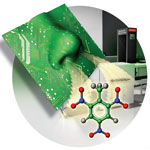 Semiconducting nanowires are known to be extremely sensitive to chemical species adsorbed on their surfaces. For a nanowire device, the binding of a charged analyte to the surface of the nanowire leads to a conductance change, or a change in current flowing through these tinny wires. Their one-dimensional nanoscale morphology and their extremely high surface-to-volume ratio make this conductance change to be much greater for nanowire-based sensors versus planar field-effect transistors, increasing the sensitivity to a point that single molecule detection is possible. In the last decade, it has been demonstrated that these new nanostructures can be used for the detection of multiple biomolecular species of medical diagnostic relevance, such as DNA and proteins. In recent work, researchers have used the ultrasensitive recognition properties of semiconducting silicon nanowires to demonstrate the most sensitive ever published sensing of explosives reported so far.
Semiconducting nanowires are known to be extremely sensitive to chemical species adsorbed on their surfaces. For a nanowire device, the binding of a charged analyte to the surface of the nanowire leads to a conductance change, or a change in current flowing through these tinny wires. Their one-dimensional nanoscale morphology and their extremely high surface-to-volume ratio make this conductance change to be much greater for nanowire-based sensors versus planar field-effect transistors, increasing the sensitivity to a point that single molecule detection is possible. In the last decade, it has been demonstrated that these new nanostructures can be used for the detection of multiple biomolecular species of medical diagnostic relevance, such as DNA and proteins. In recent work, researchers have used the ultrasensitive recognition properties of semiconducting silicon nanowires to demonstrate the most sensitive ever published sensing of explosives reported so far.
Sep 14th, 2010
 Currently, the most common methods for sizing nanoparticles extract data from bulk measurements. These techniques are inherently averaging and so are unable to effectively resolve mixtures of different-sized particles. While individual nanoparticles can be sized using electron microscopy, this approach is time-consuming and of little utility in assembling significant population statistics. Researchers have now developed a microfluidic device for the all-electronic analysis of complex suspensions of nanoparticles in fluid. This device is capable of detecting and sizing individual and unlabeled particles as small as a few tens of nanometers in diameter at rates estimated to exceed 100,000 particles per second.
Currently, the most common methods for sizing nanoparticles extract data from bulk measurements. These techniques are inherently averaging and so are unable to effectively resolve mixtures of different-sized particles. While individual nanoparticles can be sized using electron microscopy, this approach is time-consuming and of little utility in assembling significant population statistics. Researchers have now developed a microfluidic device for the all-electronic analysis of complex suspensions of nanoparticles in fluid. This device is capable of detecting and sizing individual and unlabeled particles as small as a few tens of nanometers in diameter at rates estimated to exceed 100,000 particles per second. 
 Subscribe to our Nanotechnology Spotlight feed
Subscribe to our Nanotechnology Spotlight feed





